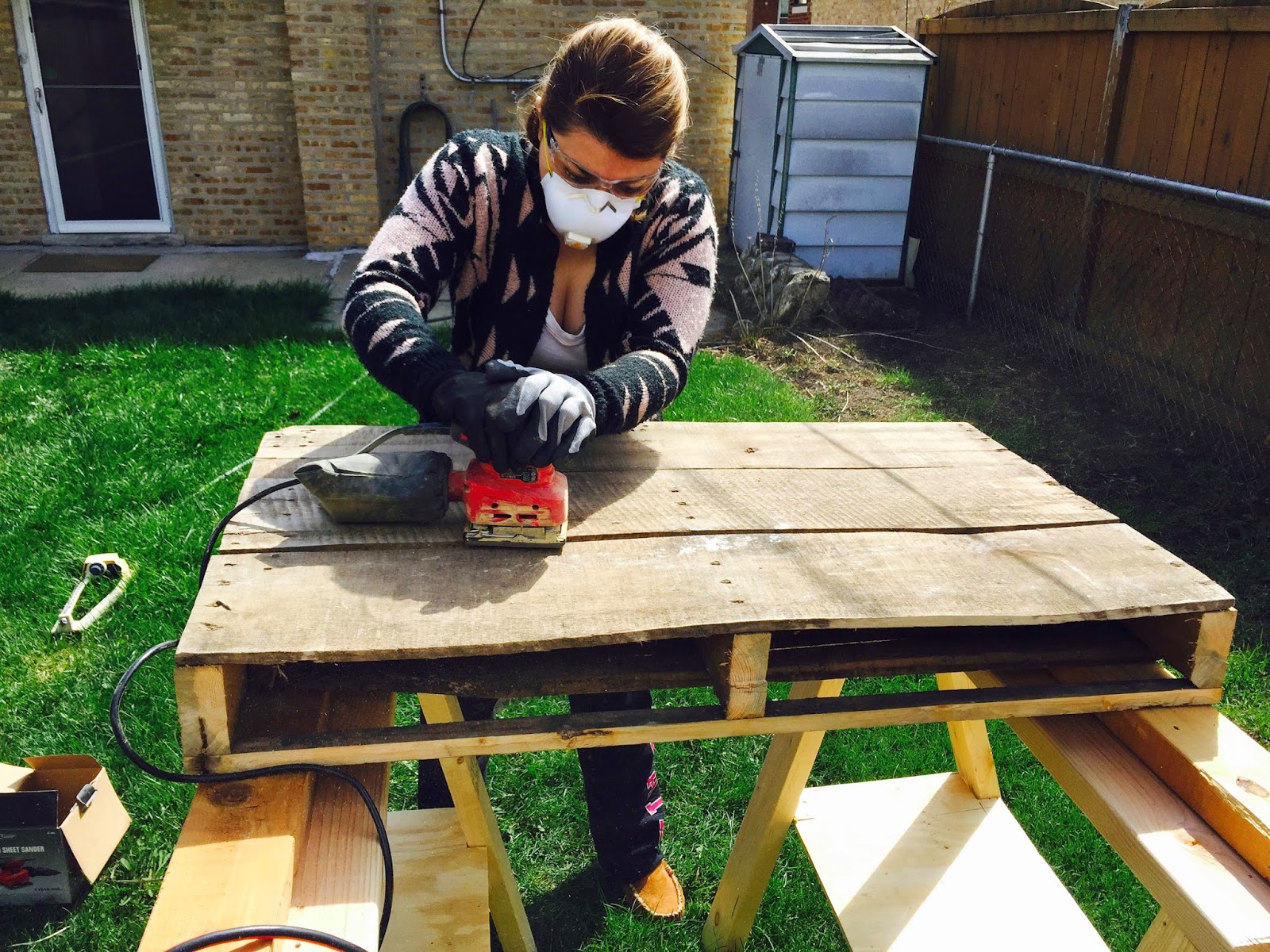Materials/Tools
1. Circular Saw
2. Sander
3. Nine (9) 40x48" pallets
4. Five (5) 2x4x8s (optional)
5. Tape measure
6. Hammer
7. Crib Mattresses
8. Outdoor Fabric
9. Pillows
 |
| Measuring to cut the pallet |
Judy and I looked for outdoor cushions, but we were not thrilled about $35 cushions from Ikea or $100 cushions from Home Depot. So, we opted for crib mattresses as suggested on the original blog. We hit craigslist and our friends and scrounged up three crib mattresses (under $40 for all three) and plan on making a cover for them using outdoor fabric. After that decision, we needed to size the pallets to fit the mattresses. A standard crib mattress measures 27.5" wide and the pallets that we used are 40x48". Use a circular saw to cut off 7.5" off the pallet's 40" side. We left 5" on the pallet to provide us with enough room for a back rest.
After cutting off the excess, we pried the remaining slats off of the excess piece and removed the nails from the thicker board. Then we placed the thicker piece of wood into the sized pallet to replace the part we removed.
 |
| Pallet Sized to 32.5" |
 |
| Side shot of mattress and place holder for backrest |
 |
| Example of backing and mattress |
Step 2 - Sizing the Chaise
The chaise is needed to be sized a little differently than the other pallets. We cut the final pallet into an L shape. The measurements are a bit tricky, but I've labeled an example below. Also, the mattress will hang about 5 inches over the pallet. But we remedied this with the next step.
Step 3 - Adding on to Chaise
Since there is about a 4 inch overhang, we needed to build a box of sorts to compensate for the 48" pallet. There are few options here: 1. build out a box using plywood, 2. use the leftover half pallet from the backrest to build out the chaise. We did the latter.
 |
| Diagram for sections 1 and 2 |
 |
| Diagram for L (section 3) |
Diagrams of Pallet Couch Sections (Note: diagrams are not to scale)
 |
| Section 1, 2, and 3 attached (note: overhanging mattress is not addressed in diagram) |
We left all the parts separate for easier storage. In other words, the pallets are not attached and back rest is simply resting on 2x4s. To make the backrests, we cut two pallets in half and attached 2x4s to the backside. We measured out 2x4s and used deck screws to attach the 2x4s to the shorter end of the pallets. Since the couch will be up against the garage, we decided simply push the base against the 2x4s to keep the backrests in place.
 |
| Guide Line for Saw |
 |
| Cutting Pallet in Half for Backrest |
 |
| Backrest |
Step 5 - Sanding down the backrest
The pallets were quite dirty, so we decide to sand and poly them to cut down on the amount of dirt and splinters for our guests.
 |
| Judy working the sander on the backrest |
 |
| Close up |
What really makes this piece stand out are the cushions and pillows. Judy and I picked out some outdoor fabric from Joann's. The fabric for the cushions is outdoor fabric, but the pillows are made of canvas. We asked my mom to sew the pillow cases and cushions, so a huge thank you to her! There are tons of options for a backrest and the cushions (we kicked around the idea of using a bolster, but went with the pillows instead). We opted for the crib mattresses because they are significantly cheaper than buying $75/yard foam. We bought/found the three of our cushions for $38 on craigslist. The pillows are from Joanns too.
 |
| My buddy and I breaking in the couch |
We really enjoyed this project and can't wait to share this couch with out family and friends. We'll send updates if we make anything else or notice any issues. Thanks for reading and please subscribe/share!
- Save some time by using 2x4s to fill in for the pallet end. We did our best and were able to salvage most of the pallet, but the time we spend on removing nails would have been better spent doing other things. So, if we ever do this again, we would definitely use 2x4s to replace those ends (the one marked with a red arrow). See picture for more details.














